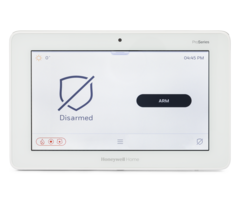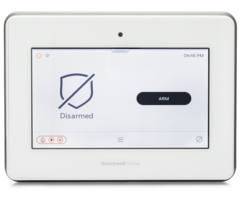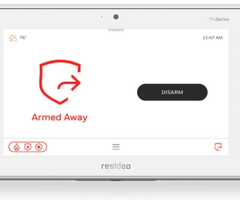How Does a Common Lobby Work on a PROA7 or PROA7PLUS?
A common lobby on a PROA7 or a PROA7PLUS allows users of multiple separate areas, to have access to a common area. The common area will automatically arm after the last of the initial separate areas arm. Users of the separate areas can be kept isolated but all will have common area access.
This article specifically mentions the Honeywell Home PROA7 and the Honeywell Home PROA7PLUS, but also applies to the Resideo PROA7C and the Resideo PROA7PLUSC. The PROA7 and PROA7C are almost identical, and the PROA7PLUS and the PROA7PLUSC are almost identical. The only difference between the Honeywell Home version and the Resideo version (with a "C" at the end) is the labeling on the front of the panel.

The PROA7 and the PROA7PLUS are sleek 7" color touchscreen, All-In-One alarm systems. They both support up to four (4) partitions. A partition sometimes referred to as an area, is a portion of the premises that you want to be able to arm and disarm separately from other areas of the protected premises. You can read about some of the differences between these two panels here.
In some locations there exists one area that is shared between two other areas. This configuration is prime for a common partition setup. One example is a physician's office with two doctors, one on each side with a common waiting area. The doctor's offices can exist separately, and can be armed and disarmed individually while sharing a common lobby, in the form of the waiting area.
This common lobby partition can only be armed if both doctors' offices are closed and armed. However, the common lobby can be disarmed first, when necessary. Disarming the common lobby first will not automatically disarm any other partition. The use of a common lobby can also work in the instance of a basement hallway that accesses two separate rooms that a homeowner wants to protect independently. One room may contain a gun closet while the other has a home office. Whatever the setup, a shared area is easily configured as a common lobby partition.
In order to configure a common lobby, at least two initial partitions must exist. For that reason, only Partition 3 or Partition 4 can be configured as the common lobby. When Partition 3 is configured as the common lobby, then Partition 1 and Partition 2 will both automatically arm and disarm the common lobby. When Partition 4 is the common lobby, then Partitions 1, 2, and 3 will all automatically control the lobby.
Let's say that Partition 1 and Partition 2 both get armed, and Partition 3 is set up as the common lobby. Partition 3 will automatically arm when the last of the other two partitions is armed. Any zone that is faulted, or open in the common lobby partition will be bypassed automatically before the common lobby is armed. When disarming the system, you can disarm Partition 3 first, without first disarming Partition 1 or 2. Or, you can disarm either Partition 1 or 2 and Partition 3 will automatically disarm. User Codes associated with Partitions 1 and 2 will automatically have Partition 3 or common lobby access.
When using more than one partition, many choose to add a keypad for each partition. The PROA7 and PROA7PLUS support up to (8) keypads per partition. They support the PROWLTOUCH or PROWLTOUCHC touchscreens which look identical to the panel itself, or a PROSIXLCDKP alphanumeric LCD keypad, as shown below.

When using the panel or the touchscreen keypads, you have a dropdown menu immediately above the panel's status. This is called the 'Goto' option. This allows you to log onto another partition instead of the normal home partition. The screen will automatically revert back to the home partition two (2) minutes after the last keypad touch occurs. Using the 'Goto' option, you can log onto any partition your user code has access to, and control that partition, even if you are not physically near it.

If you have a sensor setup as a 24-hr zone, meaning it will cause an alarm when tripped, whether the panel is armed or not, and this zone is assigned to the common lobby, an alarm on this zone will sound on all partitions' keypads. However, only the common lobby keypad, or a keypad where you use the 'Goto' command to access the common partition, can be used to silence the alarm.
The common lobby option is only available for Partitions 3 or 4. This is because there must be a minimum of 2 other partitions enabled in order to configure a common area. To enable additional partitions on a PROA7 or PROA7PLUS, from the Home screen select: Menu (≡) > Tools > Programming > Partitions > '+'. Next, you have options to name and configure the partition as desired. Always select 'Save' at the top when your programming is complete.
After you have enabled the first couple of partitions, then you can enable the common lobby partition. When on the setup and configuration page as mentioned above, you will notice a new option for Common Partition at the bottom. Scroll to the bottom and select the Common Partition slider. This option is only available upon initial setup. The ProSeries panel will not allow you to edit a partition in order to enable or disable the Common Partition option. The partition would need to be deleted, then re-enabled to change this selection.

A PROA7 or PROA7PLUS panel is the true definition of "All-in-One". It is packed full of features, such as the Common Partition, that make it a great option over its predecessor, the Lyric Controller. One such feature that is new to the PROA7 and the PROA7PLUS is called 'Quiet Time'. This feature quiets lower priority troubles during regular sleeping periods. Between 10 pm and 8 am the panel will display, but will not annunciate, troubles such as Communicator Troubles, System Low Battery troubles, RF Transmitter Low Battery, RF Jam Trouble, AC Loss, and PROWLTOUCH Keypad Supervision Troubles. This makes sure that these messages do not interrupt your sleep, and if the trouble still exists at 8am, it will annunciate at that time.
Did you find this answer useful?
We offer alarm monitoring as low as $10 / month
Click Here to Learn MoreRelated Products




Related Categories
- Apartment Security Systems
- Home Automation Controllers
- Wireless Touchscreen Alarm Panels
- Small Business Security Systems
- Monitored Home Security Systems
- DIY Wireless Security Systems
- Answered
- Answered By
- Fred Daniels



